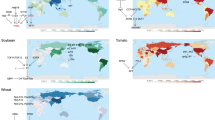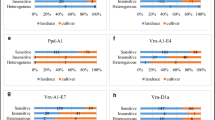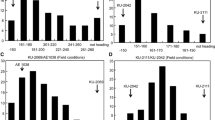Abstract
Photoperiod response genes play a major role in determining the climatic adaptability of European wheat varieties. Photoperiod insensitivity, in the vast majority of photoperiod insensitive European wheat varieties, is probably determined by a Ppd1 allele originally derived from the old Japanese variety Akakomugi. Analysis of the pleiotropic effects of a Ppd1 allele from the Italian variety Mara shows that, besides accelerating ear emergence time, Ppd1 also reduces plant height, tillering, and spikelet numbers. Increases in spikelet fertilities more than compensate for reduced spikelet numbers, producing increased numbers of grains per ear. In southern Europe, early flowering Ppd1 genotypes produce larger grain and greater yields. In England and Germany, pleiotropic effects of Ppd1 on yield vary annually, depending on prevailing weather conditions, from +9% to -16%, over a 10 year period in the United Kingdom. A possible alternative Ppd1 allele from the CIMMYT variety Ciano 67 was compared to that from Mara. Differences associated with complete substituted chromosomes were found to be due to linked genes rather than different Ppd1 alleles. Examination of an alternative weaker gene for photoperiod insensitivity, Ppd2, shows this to exert similar but less significant pleiotropic effects to Ppd1. In the UK, in each of three years of trialing, Ppd2 increased yield 6% more than Ppd1. Results of 10 years trialing show that in Central European countries, between areas where photoperiod sensitive or photoperiod insensitive varieties have a clear adaptive significance, the annual variations in climate make it extremely difficult for breeders to produce varieties with good adaptability to changing environmental conditions.
Similar content being viewed by others
References
Börner, A., A.J. Worland, J. Plaschke, E. Schumann & C.N. Law, 1993. Pleiotropic effects of genes for reduced height (Rht) and day length insensitivity (Ppd) on yield and its components for wheat grown in middle Europe. Plant Breeding 111: 204–216.
Devos, K.M. & M.D. Gale, 1993. The genetic maps of wheat and their potential in plant breeding. Outlook on Agriculture 222: 93–99.
Foulkes, M.J., R.K. Scott & R. Sylvester-Bradley, 1994. Suitabilities of UK winter wheat varieties to soil and husbandry conditions. Plant Varieties and Seeds 7: 161–181.
Faridi, N.I., 1988. Genetical studies of grain protein and developmental characters in wheat. PhD. thesis, University of Cambridge, 1988.
Gale, M.D., C.N. Law, G.A. Marshall, J.W. Snape & A.J. Worland, 1982. Analysis and evaluation of semi-dwarfing genes in wheat including a major height reducing gene in the variety Sava. In: Semi-dwarf Cereal Mutants and their use in Cross-Breeding, pp. 7–23. IAEA-TECDOC 268, Vienna.
Halloran, G.M. & C.W. Boydell, 1967. Wheat chromosomes with genes for photoperiodic response. Canad J Genet Cytol 9: 394–398.
Hoogendoorn, C., 1985. A reciprocal F1 analysis of the genetic control of ear emergence, number of leaves and number of spikelets in wheat. Euphytica 34: 545–558.
Hunt, L.A., 1979. Photoperiodic responses of winter wheats from different climatic regions. J Plant Breeding 82: 70–80.
Law, C.N., 1966. The location of genetic factors affecting a quantitative character in wheat. Genetics 53: 487–498.
Law, C.N., J. Sutka & A.J. Worland, 1978. A genetic study of daylength response in wheat. Heredity 41: 185–191.
Martiníc, Z.F., 1975. Life cycle of common wheat varieties in natural environments as related to their response to shortened photoperiod. Z Pflanzenzuchtung 75: 237–251.
Miura, H. & A.J. Worland, 1994. Genetic control of vernalisation and day length responses and earliness per se by the homoeologous group 3 chromosomes in wheat. Plant Breeding 113: 160–169.
Petrovíc, S. & A.J. Worland, 1988. The use of reciprocal monosomic ananlysis to detect variation between certain chromosomes of the wheat varieties Bersée and Sava. In: T.E. Miller & R.M.D. Koebner (Eds.), Proceedings of the 7th International Wheat Genetics Symposium, pp. 629–633. Institute of Plant Science Research, Cambridge, UK.
Scarth, R.. & C.N. Law, 1984. The control of daylength response in wheat by the group 2 chromosomes. Z Pflanzenzuchtung 92: 140–150.
Strampelli, N., 1932. Early ripening wheats and the advance of Italian wheat production, pp. 5–7. Tipografia Failli, Rome.
Suarez, E.J., T.E. Miller, A.J. Worland & C.N. Law, 1996. The influence of the group 1 chromosomes of wheat on ear-emergence times and their involvement with vernalisation and daylength. (in press).
Welsh, J.R., D.L. Kein, B. Pirasteh & R.D. Richards, 1973. Genetic control of photoperiod response in wheat. In: E.R. Sears & L.M.S. Sears (Eds.), Proceedings of the 4th International Wheat Genetics Symposium, pp. 879–884. Agricultural Experimental Station, University of Missouri, USA.
Worland, A.J., 1996. The influence of flowering time genes on environmental adaptability in European wheats. Euphytica 89: 49–57.
Worland, A.J.& C.N. Law, 1985. Genetic analysis of chromosome 2D of wheat. I. The location of genes affecting height, day-length insensitivity, hybrid dwarfism and yellow rust resistance. Z Pflanzenzuchtung 96, 331–345.
Worland, A.J., S. Petrovíc & C.N. Law, 1988a. Genetic analysis of chromosome 2D of wheat II. The importance of this chromosome to Yugoslavian varieties. Plant Breeding 100: 247–259.
Worland, A.J. C.N. Law & S. Petrovíc, 1988b. Pleiotropic effects of the chromosome 2D genes Ppd1, Rht8 and Yr16. In: T.E. Miller & R.M.D. Koebner (Eds.), Proceedings of the 7th In394 ternational Wheat Genetics Symposium, pp. 669–674. Institute of Plant Science Research, Cambridge, UK.
Worland, A.J. C.N. Law & S. Petrovíc, 1990. Height reducing genes and their importance to Yugoslavian winter wheat varieties. Savremena Poljoprivreda 38: 245–258.
Worland, A.J., M.L. Appendino & E.J. Sayers, 1994. The distribution of genes influencing ecoclimatic adaptability in European winter wheat varieties. Euphytica 80: 219–228.
Author information
Authors and Affiliations
Rights and permissions
About this article
Cite this article
Worland, A., Börner, A., Korzun, V. et al. The influence of photoperiod genes on the adaptability of European winter wheats. Euphytica 100, 385–394 (1998). https://doi.org/10.1023/A:1018327700985
Issue Date:
DOI: https://doi.org/10.1023/A:1018327700985




